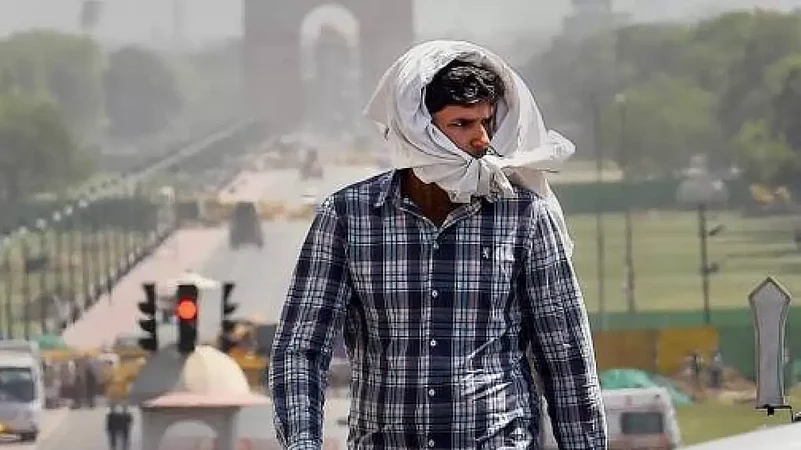A blistering heatwave swept parts of Delhi with maximum temperatures breaching the 46-degree mark on Monday, straining power grids and posing challenges to outdoor labourers, homeless people and animals.
The sweltering conditions saw the peak power demand in Delhi soar to 6,532 MW around 3:30 pm, the highest so far this season, officials said.
The city had recorded a peak power demand of 7,695 MW last summer and it might reach 8,100 MW this year, they said.
What did IMD say?
The India Meteorological Department (IMD) predicted that similar conditions would continue before rains bring some relief from Wednesday onwards.
Delhi's primary weather station, Safdarjung Observatory, recorded a maximum temperature of 43.7 degrees Celsius -- four notches above normal and the maximum so far this year.
The mercury soared to 46.2 degrees Celsius at Najafgarh, making it the hottest place in the capital.
Narela (45.3 degrees Celsius), Pitampura (45.8 degrees Celsius) and Pusa (45.8 degrees Celsius) also recorded heatwave conditions.
The threshold for a heatwave is met when the maximum temperature of a station reaches at least 40 degrees Celsius in the plains, at least 37 degrees Celsius in coastal areas, and at least 30 degrees Celsius in hilly regions, and the departure from normal is at least 4.5 degrees Celsius.
The IMD said a western disturbance active over the western Himalayan region is predicted to bring rain, hailstorm and gusty winds in the northwestern plains starting Wednesday. As a result, the maximum temperature will drop to 36 degrees Celsius by Thursday, it said.
Earlier this month, the Met office had predicted below-normal maximum temperatures and fewer heatwave days in northwest India in May.
With the IMD anticipating a slight delay in the arrival of the southwest monsoon, the maximum temperatures are likely to remain above normal for a longer-than-usual period.
Exacerbating weather conditions in India
Heatwaves in India are becoming more frequent and severe due to climate change, with over 90 per cent of the country in the "extremely cautious" category or "danger zone" of their impacts, according to a study conducted at the University of Cambridge.
The study also revealed that Delhi is particularly vulnerable to severe heatwave impacts, despite its recent state action plan for climate change failing to reflect this fact.
April's record-breaking heatwave in Bangladesh, India, Laos and Thailand was made at least 30 times more likely by human-caused climate change, according to an analysis conducted by a group of leading climate scientists.
Delhi had experienced a long spell of cloudy weather and sporadic rainfall from April 21 to May 7, which is rare during this time of the year. Officials had attributed this to the back-to-back western disturbances, weather systems that originate in the Mediterranean region and bring unseasonal rainfall to northwest India.
Historically, May has been the hottest month in Delhi, with a mean maximum temperature of 39.5 degrees Celsius.
According to IMD data, the Safdarjung Observatory has recorded 60.4 mm of rainfall in May so far. On an average, the capital logs 19.7 mm of rainfall in the whole month.
The city had recorded more than 20 mm of rainfall in April, the highest in the month since 2017, due to back-to-back western disturbances.
According to IMD data, India saw a 24 per cent increase in the number of heatwaves during 2010-2019 compared to 2000-2009.
Between 2000 and 2019, the mortality rate for tropical cyclones decreased by 94 per cent, whereas it increased by 62.2 per cent for heatwaves.
The Fifth Assessment Report of the Intergovernmental Panel on Climate Change said a moderate increase in average temperatures or a slight increase in the duration of heatwaves will lead to a significant increase in the mortality rate in India unless remedial and response measures are taken.
However, heatwaves are yet to be notified as a natural disaster at the national level in the country.
Heatwaves have an immense impact on human health, causing cramps, exhaustion, stress and heat stroke and very severe heat waves can even lead to death.
The elderly, children, and people with heart and respiratory problems, kidney diseases and psychiatric disorders are particularly affected.
Extreme periods of high temperatures can lead to a significant reduction in crop yields and cause reproductive failure in many crops.
This year, India experienced its hottest February since record-keeping began in 1901. However, above-normal rainfall in March kept temperatures in check.
March last year was the warmest ever and the third driest in 121 years. The year also saw the country's third-warmest April since 1901.
In India, about 75 per cent of workers (around 380 million people) experience heat-related stress.
A report by the McKinsey Global Institute warns that if this continues, the country could lose between 2.5 per cent to 4.5 per cent of its Gross Domestic Product per year by 2030.
(With PTI Inputs)
















